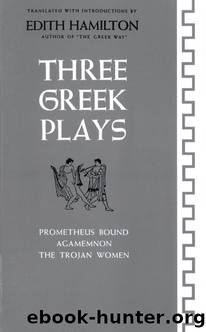Three Greek Plays by Edith Hamilton

Author:Edith Hamilton
Language: eng
Format: epub
Publisher: W. W. Norton & Company
* Shelleyâs adjective is the perfect translation. Anything else would be less exact and less like Aeschylus.
â This line of Keats is the exact translation.
VII
AN APOLOGIA
A LARGE PART OF a Greek tragedy consists of poems written in a way that is completely foreign to English poetry and, indeed, to the poetry of any other language of the Western world. There is nothing like it even in Latin poetry. In the Agamemnon, of the 1,673 lines of the play, 900 are dialogue, the rest is made up of these strange poems. They marked the division of the play into scenes, as a curtain does with us. In all probability they were not spoken but sung. The performers, whom the Greeks called the chorusâ the primary meaning of the word in Greek means danceâwere not on the stage, but in front of it, and they took, as a rule, little or no part in the action of the play. Their lines, however, usually bore upon the action and were often a kind of commentary on what was happening. In contrast to the dialogue, which was always written in a six-foot measure, felt by the Greeks, according to Aristotle, to be âbetter adapted for being spokenâ than any other, the choral poems were never written in a fixed measure, but in most varying meters that changed constantly within a single verse, often from line to line. We have no parallel to this in our poetry and the sound falls strangely on our ears. An English poem always has the same rhythmic movement. It would offend us to have a poem that began in the measure of
There is sweet music here that softer fallsswing into that of
It was many and many a year agoâ
The Greek found such changes natural and completely consonant with poetic melody:
Now is she mad of mood and by some God possessed.
Her wordsâwild they ring,
as for her fate she mourns. So wails
ever the bird with wings of brown, musical nightingale.
Noâbut a house God hates.
Murders and strangling deaths.
Kinâstriking down kin. Oh, they kill men here.
House that knows evil and evil. The floor drips red.
On the printed page these lines have the look of free verse. There is no regularity in the length of line any more than in the accents, but the resemblance to our own free verse ends there. Greatly as the lines given above vary, each has its own strongly marked rhythm. Here is no question of subtle cadences which to many a reader give only the effect of prose. They are unmistakably metrical. Furthermore, the Greek choruses are written in sets of similar verses and the two that belong to the same set must correspond in the most meticulous way. The poet was free to do what he wanted with the first verse. Every line might be in a different meter. But the second verse had to follow the irregularity of the first, line for line and syllable for syllable. Each line had to have not only exactly the
Download
This site does not store any files on its server. We only index and link to content provided by other sites. Please contact the content providers to delete copyright contents if any and email us, we'll remove relevant links or contents immediately.
Cecilia; Or, Memoirs of an Heiress — Volume 3 by Fanny Burney(30928)
Cecilia; Or, Memoirs of an Heiress — Volume 2 by Fanny Burney(30885)
Dialogue by Robert McKee(3575)
The 101 Dalmatians by Dodie Smith(2931)
Bound by Hatred (The Singham Bloodlines Book 2) by MV Kasi(2687)
Harry Potter and the Cursed Child - Parts One and Two by John Tiffany(2512)
The Beautiful Boys: A High School NA Reverse Harem Paranormal Bully Romance (Shadowlight Academy Book 1) by Gow Kailin(2497)
The Art of Dramatic Writing: Its Basis in the Creative Interpretation of Human Motives by Egri Lajos(2409)
Carrie's War by Nina Bawden(2097)
Angels in America by Tony Kushner(2045)
Unlaced by Jaci Burton & Jasmine Haynes & Joey W. Hill & Denise Rossetti(2019)
A Clockwork Orange by Anthony Burgess(1933)
The Femme Playlist & I Cannot Lie to the Stars That Made Me by Catherine Hernandez(1887)
Drama by John Lithgow(1879)
Open Book by Jessica Simpson(1793)
Outside Woman (BWWM Amish Romance) by Stacy-Deanne(1735)
Terrorist Cop by Mordecai Dzikansky & ROBERT SLATER(1716)
Yerma by Federico García Lorca(1635)
Leo's Desire by Sundari Venkatraman(1588)
